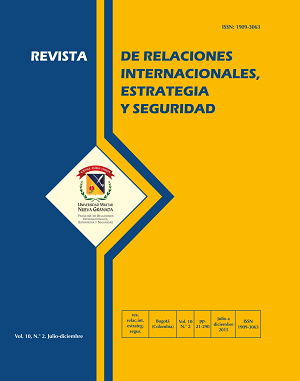Drones: ¿Hacia una guerra sin regulación jurídica internacional?
Resumen
Dadas sus ventajas, los drones se están convirtiendo en un arma fundamental en los conflictos armados contemporáneos. Este artículo tiene como objetivo dar respuesta a algunas preguntas relacionadas esa realidad: ¿Qué tan adecuada es la normatividad internacional para regularlos? ¿Será el Derecho Internacional Humanitario (DIH) la forma de evitar que se causen estragos ilimitados? ¿Será posible aplicar algún tipo de estatuto diferente al DIH para regular el uso de los drones? ¿Cómo opera el DIH cuando el Estado usa drones contra actores armados no estatales o éstos los utilicen contra el Estado? La metodología para responder a esos interrogantes consistirá en revisar y cotejar la acción de los drones con respecto al Derecho de la Guerra Aérea, al Derecho de Ginebra y a las normas sobre el uso de drones en el espacio exterior. Se encontrará que pese a la obsolescencia y generalidad de algunas normas, el DIH es plenamente aplicable al uso de los drones con fines bélicos.
Descargas
Lenguajes:
esReferencias bibliográficas
Backstrom, A. & Henderson, I. (2012). New capabilities in warfare: an overview of contemporary technological developments and the associated legal and engineering issues in Article 36 weapons reviews. International Review of the Red Cross. 94(886), 483-514.
Bangerter, O. (2011). Reasons why armed groups choose to respect international humanitarian law or not. International Review of the Red Cross. 93(82), 353-384.
Barnett, J. (1996). Future War, an Assessment of Aerospace Campaigns in 2010. Alabama: Air University Press.
Bernard, V. (2012). Science cannot be placed above its consequences. International Review of the Red Cross. 94(886), 457-466.
Bingham, T. (6 de julio, 2009) Unmanned drones could be banned, says senior judge. The Telegraph. Recuperado de www.telegraph.co.uk/news/uknews/defence/5755446/Unmanned-drones-could-be-banned-says-senior-judge.html
Bocquet, P. & Gougis, L. (2014). La Révolution Drones, Science & Vie. 1160, 54-68.
Bone, E. & Bolkcom, C. (2004). Unmanned Aerial Vehicles: Background and Issues for Congress. Washington D. C.: Congressional Research Service.
Byman, D. (2013). Why Drones Work. The Case for Washington's Weapon of Choice. Foreign Affairs. 92(4), 32-43.
Casey-Maslen, S. (2012). Pandora's box? Drone strikes under jus ad bellum, jus in bello, and international human rights law. International Review of the Red Cross. 94(886), 597-625.
Cole, A., Drew, P. & McLaughlin, R. (2009). Manual de reglas de enfrentamiento. San Remo: Instituto Internacional de Derecho Humanitario Recuperado de https://www.usnwc.edu/getattachment/ac196786-d1a7-4ad9-90dc-ebcbc6c83581/Rules-of-EngagementHandbook---%28Spanish%29.aspx
Comité Internacional de la Cruz Roja, CICR, (s.f.) Customary IHL Recuperado de http://www.icrc.org/customary-ihl/eng/docs/v2_cha
Comité Internacional de la Cruz Roja, CICR, (2013, 10 de mayo). El uso de drones armados debe estar sujeto a la ley. Recuperado dewww.icrc.org/spa/resources/documents/interview/2013/05-10-drone-weapons-ihl.htm
Consejo de la Unión Europea. (2010). Council Conclusions concerning the revised drat Code of Conduct for Outer Space Activities- 11 October 2010-14455/10-PESC 1234-CODUN34. Bruselas.
Corte Suprema de la República del Perú. Sentencia Abimael Guzmán Reinoso y otros, Perú, Expediente acumulado No. 560-03, 13 de octubre de 2006.
Covert drone war (s.f.) The Bureau of Investigative Journalism. Recuperado de http://www.thebureauinvestigates.com/category/projects/drones/.
Cumin, D. (2014). Manuel de Droit de la Guerre. Bruselas: Editions Larcier.
Daboné, Z. (2011). International law: armed groups in a state-centric system. International Review of the Red Cross. 93(882), 395-431. http://dx.doi.org/10.1017/S1816383112000057
David, É. (2008). Principes de droit des conflits armés. Bruselas: Bruylant.
Department of State (2010). The Obama Administration and international Law. Recuperado de www.state.gov/s/l/releases/remarks/139119.htm.
Enemark, C. (2014). Armed Drones and Ethics of War. Military Virtue in a Post-heroic Age. New York: Routledge.
Gallais, S. (2013). Cadre juridique de l'emploi des drones au combat. Paris: L'Harmattan.
Gertler, J. (2014). US Unmanned Aerial Systems. En Boon, K. & Lovelace, D. (Eds.), The Drone wars of the 21st Century: Costs and Benefits. Oxford: Oxford University Press.
Hofmann, C. & Schneckener, U. (2011). Engaging non-state armed actors in state- and peace-building: options and strategies. International Review of the Red Cross. 93(883), 603-621. http://dx.doi.org/10.1017/S1816383112000148
Hoppe, L. (2008). Le statut juridique des drones - Aéronefs non habités. Marsella: Presses Universitaires d'Aix-Marseille.
International Committee of the Red Cross (2006). A guide to the legal review of new weapons, means and methods of warfare: measures to implement Article 36 of Additional Protocol I of 1977. International Review of the Red Cross. 88(864).
International Criminal Tribunal for the former Yugoslavia. The Prosecutor v. Tadic, Case IT-94-1Tbis-R117, Judgment (Trial Chamber), 11 de noviembre, 1999.
International Criminal Tribunal for the former Yugoslavia. The Prosecutor v Galic, Case No IT98-29-T, Judgement (Trial Chamber), 5 de diciembre, 2003.
International Criminal Tribunal for the former Yugoslavia (ICTY) (2008), The Prosecutor v. Boskoski and Tarculovski, Case No. ICTY-IT-04-82-T, Judgment (Trial Chamber), 10 de julio, 2008.
International and Operational Law Department: The Judge Advocate General's Legal Centre & School. http://www.loc.gov/rr/frd/Military_Law/operational-law-handbooks.html
Jiménez de Aréchaga, E. (1980). El Derecho Internacional Contemporáneo. Madrid: Editorial Tecnos.
Kleffner, J. (2011). The applicability of international humanitarian law to organized armed groups. International Review of the Red Cross. 93(882), 443- 461. http://dx.doi.org/10.1017/S181638311200001X
Kreps, S. & Zenco, M. (2014). The Next Drone Wars. Foreign Affairs. 93(2), 68-79.
Kurth, A. (2013). Why Drones Fail. When Tactics Drive Strategy. Foreign Affairs. 92(4), 44-54.
Malis, C. (2014). Guerre et Stratégie au XXie Siécle. Enjeux mondiaux, armes futures. Quelle ambition pour la France? Paris: Fayard.
Nu-o, R. (1998). La Guerra Aérea en relación con el Derecho Internacional Humanitario. Recuperado de www.icrc.org/spa/resources/documents/misc/5tdm2f.htm#2
Organización de las Naciones Unidas, ONU. (2010). Anuario de las Naciones Unidas sobre el desarme, 33(II). Nueva York. ONU.
Overy, R. (2014). Sous Les Bombes. Flammarion: Paris.
Parlamento Europeo (2007). Reporte sobre el desarrollo de UAV en la Unión Europea. Bruselas.
Pénisson, B. (2013). Histoire de la Pensée Stratégique. Paris: Ellipses Édition Marketing
Pellet, A. (2012). Article 38. In Zimmermann A. et al. (Eds.), The Statute of the International Court of Justice. A Commentary (pp. 731-870). Oxford: Oxford University Press.
Pictet, J. (1998). Comentario del Protocolo del 8 de junio de 1977 adicional a los Convenios de Ginebra del 12 de agosto de 1949 relativo a la protección de las víctimas de los conflictos armados sin carácter internacional (Protocolo II) y del artículo 3 de estos Convenios. Bogotá: Plaza & Janés.
Reed, A. (1979). Unmanned Aircraft. Londres: Brassy's.
Reglas de Derecho Internacional Humanitario Consuetudinario del Comité Internacional de la Cruz Roja. Recuperado de http://www.icrc.org/eng/assets/files/other/customary-law-rules.pdf
Remiro, A. (2010). Derecho Internacional. Valencia: Tirant Lo Blanch.
Ronzitti, N. (2006). The Codification of Law of Air Warfare. En Ronzitti, N. & Ventutini, G. (Eds.), The Law of Air Warfare: Contemporary Issues (pp. 3-16), Utrech: Eleven International Publishing.
Sassóli, M. & Bouvier, A. (2005). How Does Law Protect in War? Ginebra: Comité Internacional de la Cruz Roja.
Sassóli, M. (2011). Introducing a sliding-scale of obligations to address the fundamental inequality between armed groups and states? International Review of the Red Cross. 93(882), 426-431.
Schimtt, M., Garraway, C. & Dinstein, Y. (2006). The manual on the law of non-international armed conflict with commentary. San Remo: International Institute of Humanitarian Law. Recuperado de http://www.iihl.org/iihl/Documents/The%20Manual%20on%20the%20Law%20of%20NIAC.pdf
Shaw, M. (2008). International Law. Cambridge: Cambridge University Press. http://dx.doi.org/10.1017/cbo9780511841637
Sinno, A. (2011). Armed group's organizational structure and their strategic options. International Review of the Red Cross, 93(882), 311-332. http://dx.doi.org/10.1017/S1816383111000348
Stewart, J. (2003). Towards a single definition of armed conflict in international humanitarian law: a critique of internationalized armed conflict. International Review of the Red Cross. 85(850), 313-350. http://dx.doi.org/10.1017/S1560775500115196
Taylor J. & Munson, K. (1977). Jane's Pocket Book of RPVs: Robot Aircraft Today, Londres: Macdonald & Jane's.
Villiger, M. (1997). Customary International Law and Treaties. La Haya: Kluwer Law International.
Zubeldia, O. (2012). Histoire des Drones. Paris: Perrin.
Zucchino, D. (2012, 29 de mayo). US Report faults Air Force drone crew, ground commanders in Afghan civilian deaths. Los Angeles Times. Recuperado de http://articles.latimes.com/2010/may/29/world/la-fg-afghan-drone-20100531












